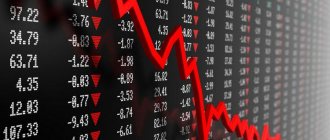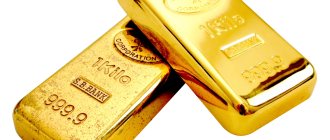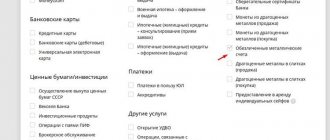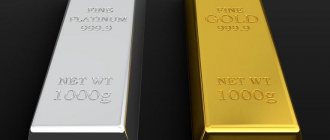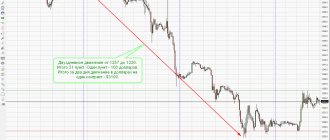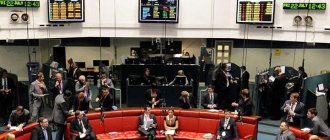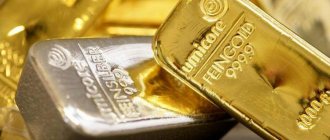The current price of gold is 1,846.80 per 1 troy ounce (31.1 grams). Today the price is trading in the range: 1844.20-1868.10. Price at the end of the previous day: 1861.40. Change for today -$14.60, -0.78%.
| 1846.80 | -0.78% |
Recent changes:
| Period | 2 days | 3 days | A week | 2 weeks | 1 month |
| Change,% | -0.74% | -1.06% | -1.08% | +1.14% | +3.69% |
| Price | 1860.60 | 1866.60 | 1866.90 | 1826.00 | 1781.00 |
Oil price online.
Dollar exchange rate forecast for the month and 2021-2024.
What precious metals are listed on the London LME?
There is no separate exchange for trading precious metals. These products are presented on the London Metal Exchange LME, New York NYMEX, Chicago CBT and CME, Tokyo TSE.
But one of the most important is the stock exchange in London. The thing is that twice a day a gold fixing is established on this site, which determines the price of gold and is the most important reference point for all other precious metals exchanges. In addition, since 1987, the LME has been fixing prices for silver.
The LME offers trading in futures for the following precious metals: gold, platinum, palladium, silver. The price is determined per troy ounce, which in the metric system is 31.1034768 grams.
The gold stablecoin market is overheated
Tether Gold is far from a unique offering on the market. The idea of tying cryptocurrency to gold has already been implemented in stablecoins Paxos, Digix, Ekon Gold, NovemGold, CoinShares and several dozen other, less popular ones.
Investors traditionally consider gold a safer instrument during a crisis. Traders use stablecoins to hedge risks. “Golden” tokens are attractive due to lower interest rates, expectations of a recession, and increased regulation of the crypto industry. DeCenter has already looked into why the demand for gold from central banks is growing, and the reasons why some experts believe that if the world economy collapses, then this precious metal will help restart it.
At the same time, the market for “golden” stablecoins is now overheated - there are many projects, but most of them do not stand out in any way and, most likely, will close soon. Perhaps in a few years obvious leaders will appear on the market, but so far there are none. As for Tether Gold, it is far from the most reliable project in this sector of the crypto market. For example, PAX Gold's issuer, Paxos, has a crypto trust license from the New York State Department of Financial Services (NYDFS). The issuer Ekon has a license from the Swiss Association of Financial Services Standards (VQF) under the National Financial Regulator FINMA: the project is audited quarterly by the independent auditing company PluriAudit SA, and all gold is insured and stored in a safe at a specific store in Switzerland. The issuer Novem Gold is also regularly audited by Grant Thornton, and gold is stored in Liechtenstein in full compliance with local legislation. The AgAu token collateral is also held in Liechtenstein and is verified by E&Y, one of the “Big Four” auditing and consulting firms. Issuer Anthem Gold stores gold in the US, all metal is insured, and the storage can be monitored online. The only advantage of Tether Gold over similar stablecoins is the absence of storage fees.
However, even with all the advantages, no gold-backed stablecoin has ever taken off in the market. Thus, PAX Gold’s capitalization is $14.6 million, daily trading volume is $350,000, Digix Gold’s is $6 million and $168,000, respectively. The performance of other tokens is no better and we don’t think that Tether Gold will be able to surpass them.
Price dynamics
Precious metals quotes experience ups and downs in the same way as other exchange instruments. In general, they have, of course, grown over the foreseeable historical period. But for speculative trading or investing, it is important to monitor and understand short-term fluctuations in the precious metals exchange.
How have quotes changed over the past 10 years?
The prices for precious metals may generally be the same. For example, there is a growing trend on exchanges for all types of precious metals. But they can grow in different ways; rollbacks or fluctuations can occur with different intensity. To understand the essence of the process, I will consider quotes for 10 years for all types of metals.
Gold
For the first time, the precious metal reached the mark of $1,000 per troy ounce on the stock exchange in March 2008. Then a rollback occurred, and for the second time a troy ounce of gold reached this symbolic mark in February 2009.
It was not possible to break through such a strong resistance line for the second time, and from February to September 2009, quotes fluctuated from 880 to 990. And then the resistance was broken and a sharp increase occurred - in November 2009 the price reached 1226. This often happens after prices were able to overcome strong resistance. Growth can be fast and strong.
But then a rollback to 1070 and an assault on new heights since May 2010. Here the growth was not so sharp, but quite stable, in almost all months (except July 2010), it brought quotes to the level of $1,418 by December.
A slight pullback in January 2011 to the level of 1318 and a new rise to 1911 in August of the same year. This decline was interspersed with attempts to rise to 1750, but overall the price of the precious metal on the exchange was closer to $1500.
In September 2011, the decline began to 1536. From October 2012 and the level of 1790 dollars per ounce, gold began to slide down. The fall stopped in June 2013 at the level of 1194.
Until June 2015, gold was in a sideways trend; the price range of the precious metal on the stock exchange was 1140-1400 with a slight tilt towards the lower edge.
And in July 2015, the support level was broken, prices went lower, to 1054.
Quotes bounced off this level in February 2021 and went up to 1370 in July. But in December the level was again at 1054, and in September 2021 the level was 1350. After a slight decline, the next three months again attempted growth to 1367 in January 2021.
In August 2021, the price of gold was again at the lower limit of the corridor - 1158. But over the last year, gold has been in a growing trend, the price on the stock exchange reached $1440 per troy ounce.
Silver
The minimum value of the precious metal on the stock exchange over the past 10-12 years was 8,300 in October 2008.
Then a three-year upward trend, during which silver prices increased more than fivefold and reached $49,836 per troy ounce in April 2001. However, in May, silver prices fell to 32,400. True, in August of that year, quotes on the stock exchange rose to 44, but this was a short-term surge, and in September the price even dropped to 26.
Until March 2013, the rate fluctuated in the price range of 26-36, until from April to June it dropped to 18.
A local minimum of $13,700 per ounce of the precious metal was reached in December 2015.
Since then, for almost four years, silver prices have been more or less stable and range from 13 to 18. The exception was June-July 2016, when quotes tried to go beyond the corridor, but the most they were able to do was try to overcome the level at 20 dollars.
In stock quotes of silver, unlike gold, the sideways movement continues. As you can see, trends for precious metals do not always coincide.
Platinum
A review of the last decade of platinum quotations on the stock exchange should begin with the peak: December 2007 - February-March 2008 - October 2008. Accordingly, the price per troy ounce: 1445 - 2305 - 754 dollars. In less than a year, there was almost a twofold increase, and then a threefold decline.
In November 2008, a phase of growth in precious metal quotations began, which stopped in April 2010 at the level of 1758. A five-month fluctuation was 144-1648 and a smooth increase to 1882 in May 2011.
This level remained until September 2011, when platinum fell in price to 1472.
The price range for the precious metal was 1418–1674 until June 2013. Then the levels dropped to 1336–1472, but the trend remained sideways. Volatility during this period was low, prices changed, but not very much.
But in August 2014 the rate went down. At first it looked like a fluctuation in the corridor (movement towards the lower border). But without any difficulties or special pullbacks, quotes dropped to $827 per ounce by the end of 2015.
True, in August 2021 they even reached 1200, but this was only a surge in a generally sideways trend with boundaries at the levels of $796-1020.
This movement continues to this day.
Palladium
Palladium at the beginning of 2009 was priced on the stock exchange in the range of $170-190 per ounce. At this time, a growing trend began that became steeper. In April 2010, an ounce cost $572. Then a decline in May to 392, the next month of fluctuations around 450 and a sharp jump to 805 in December.
The whole of 2011 saw fluctuations in a sideways trend from 688 to 848. August-September of that year were bad months for the palladium market, the price went to 532.
However, by March 2013, with rollbacks and decreases in quotations, prices for the precious metal rose to $787.
But the real growth began in February 2014 from the level of $702. By August there were already 907.
And then from September 2014 to January 2021 they dropped to $453 per ounce.
In February 2021, a new growing trend began, during which quotes rose to $1,130 in January 2021, and after falling in August just below the 900 mark, new peaks were stormed: 1,549 in February 2019 and 1,571 in July.
Palladium, unlike all precious metals, is currently in a phase of rapid growth and is reaching historical price records.
What affects the cost of precious metals
First of all, the price of a precious metal on the stock exchange is affected by the price of its extraction. It must be borne in mind that the times when kilogram-sized gold nuggets could be mined in the river are long gone. The metal content in ore ranges from several percent to tenths of a percent. This is if we take all the ores of the deposit.
Palladium and platinum are very often mined from base metal ore deposits, along with copper and nickel. It is not for nothing that the main producer of these metals in Russia is Norilsk Nickel.
To obtain precious metals, a huge amount of ore must be processed. Moreover, most of this ore is mined in mines.
The rise in global reserves (or fall) of precious metals, combined with demand, also affects prices. In addition to the jewelry industry, precious metals are used in electronics, the chemical industry, and mechanical engineering. The development of new technologies and increased demand always contribute to an increase in prices on the stock exchange, since it is not possible to quickly increase production.
How to analyze the precious metals market
When analyzing the precious metals market, you need to monitor changes in reserves - this, first of all, can affect long-term stock quotes. For shorter periods, be sure to look at metal production schedules and demand for them in the global market.
But besides this, precious metals, especially gold, are a defensive asset. During the depreciation of stocks and currencies, gold takes on the form of a defensive asset; the demand for it grows depending on the behavior of the securities or currency market.
Tether will have a hard time regaining investor confidence
The main problem facing a new issuer of a new stablecoin is regaining investor confidence. Those who have followed Tether's history closely will find it difficult to convince them to trust the company.
Starting in 2021, Tether is asked to prove that its tokens are actually backed by fiat currencies. As a result, in the spring of 2019, the company admitted that only 75% of USDT is backed by dollars and securities. But given the growing capitalization of the coin, which has already reached $4.65 billion, and the fact that the company has never conducted an independent audit, most likely this figure is even lower.
Fluctuations in the USDT rate from launch to the present.
The token price changed from $0.91 to $1.11. Source. The coin's rate has repeatedly dropped below the dollar. In the spring of 2019, the New York State Attorney's Office accused Bitfinex and Tether of defrauding customers and using the exchange's USDT reserves to cover losses of $850 million. In October last year, in New York, a class action lawsuit was filed against Tether by investors for a record $1.4 trillion on charges of market manipulation during the 2017–2018 crypto boom.
Tether assures investors that its new token is fully backed by physical gold, but again does not provide any evidence. The name or any specifications of the Swiss vault are unknown, there are no images of the metal, no online broadcast from the vault, and it is not clear which bank or organization the company is working with. No documents were provided confirming the presence of metal or contracts indicating this. But in the terms of service it is written that the company does not insure user funds and in the event of bankruptcy is not obliged to pay compensation to customers. It is not surprising that a significant part of the crypto community took the news with disbelief.
So you will be able to press 2 button's and create 'Gold'
